" Ruins are like sentinels on the border of time, which eludes us because of its fluidity; on the one hand they stand before the time that has invested and shaped them, reducing them to a collapsed wall, ghosts of a once intact building; on the other hand, precisely this stubborn resistance to the inexorable passage of time gives ruins a sense of duration making them an anchor for memory " (M. Blackbeard, A. Capodiferro, The Power of Ruins)
The case
If Brodskji knew what hands Venice and part of Italy’s heritage are in today, he would pale. Especially if he knew about the latest affair of that marginal, insignificant appendage that, still in the eyes of many, is Calabria, (perhaps that is why a case like this finds little space in national newspapers?) who knows if he would still write about an Italian place words like these: " The surrounding beauty is such that one is immediately seized by an absolutely incoherent, animalistic urge to stand up to it, to catch up with it . "
Would anyone, and particularly a Calabrese, as a cultured tourist in Venice did in Iosif Brodsky’s time, dress up and try to rival the beauty of the landscape or a place in his land? We have no certainties, but today perhaps Italy would not have inspired the Russian poet to write a masterpiece like The Foundations of the Incurables : a short novel, yes, but above all a digression, a declaration of love for a city that stands on a body of water, Venice.
Speaking of the case of the Calabrian abbey of Corazzo in Carlopoli, whose recently unveiled restoration and enhancement project could compromise its identity, perhaps, however, Brodsky would use, along the lines of Ruskin, the words of Vito Barresi: “cathedral of the sacred and the mystical, made eternal by neglect and oblivion” . The same journalist, with a couple of articles, some removed from the social networks, in addition to ’extolling’ with those precious verses the historical and architectural value of the abbey, bounces with indignant frown from the chair of his editorial staff for what that, in the silence of many of his co-religionists, could happen to the ruins of Corazzo and how the aforementioned restoration project, about to begin, could distort not only its historical value, memory, but also its beauty and charm as a ’ruin’. As well as causing damage to the structural seal.
A strong and decisive reaction, however, we are sure, would not have been lacking: the voice of Emilia Zinzi, who dedicated long studies to Corazzo, led by archaeologist Francesco A. Cuteri, would have echoed, giving courage to the most pusillanimous. A woman, yes, from these places, a scholar as tenacious as she is, if she could return from the world of the Underworld, would not have hesitated to gain Carlopoli, (the Calabrian municipality where the abbey is located), in a hurry, to rebel in front of the gates of the monument, in order not to allow such beauty to be scarred.
Perhaps many, many, would be outraged, if they knew the history of this treasure chest of ruins, (that’s why we tell it), and what about the Calabrians?
The “non-final” project (so they clarify, probably after a kind of “controversy” that arose on the web and that so far has been limited to this and questioned the value of conservative character) involves the practice of “crystallization” (where the use of concrete is feared ) .
In our opinion, a few complaints, and a few sporadic and never communitarian outbursts, in defense of a common good are not enough: if this purpose of “competent havoc” is not stopped, if no one speaks up and makes their voices heard, if only to legitimately expose some reasonable doubts, it means that we are all complicit.
 |
| Corazzo Abbey. Ph. Credit |
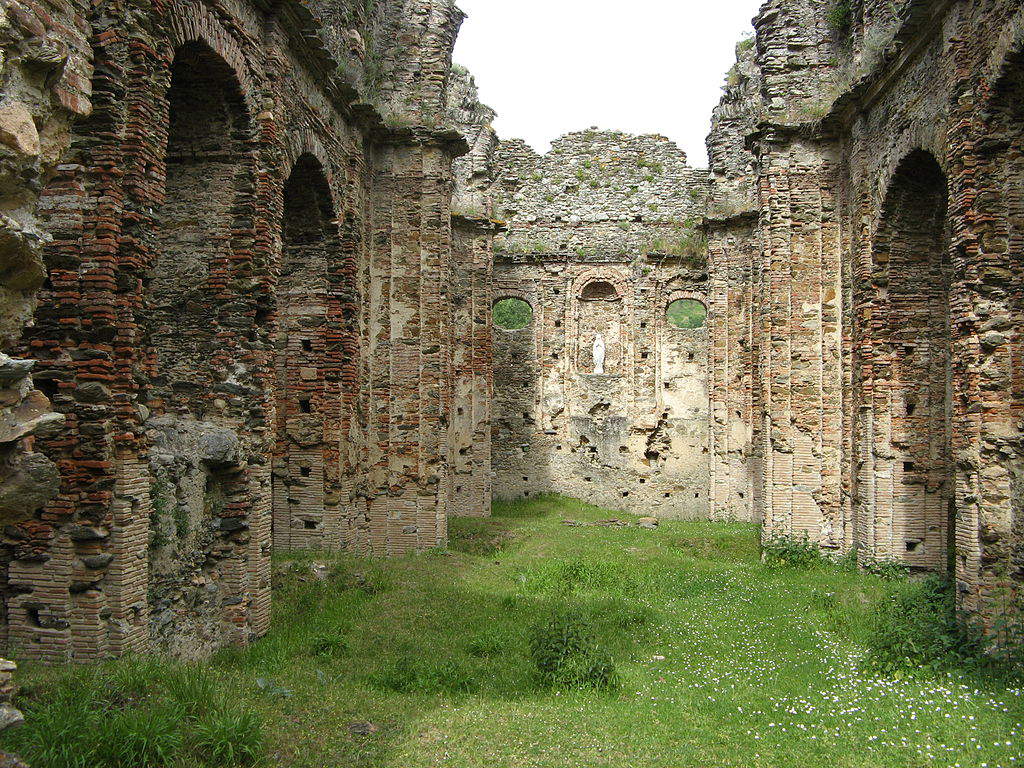 |
| Corazzo Abbey. Ph. Credit |
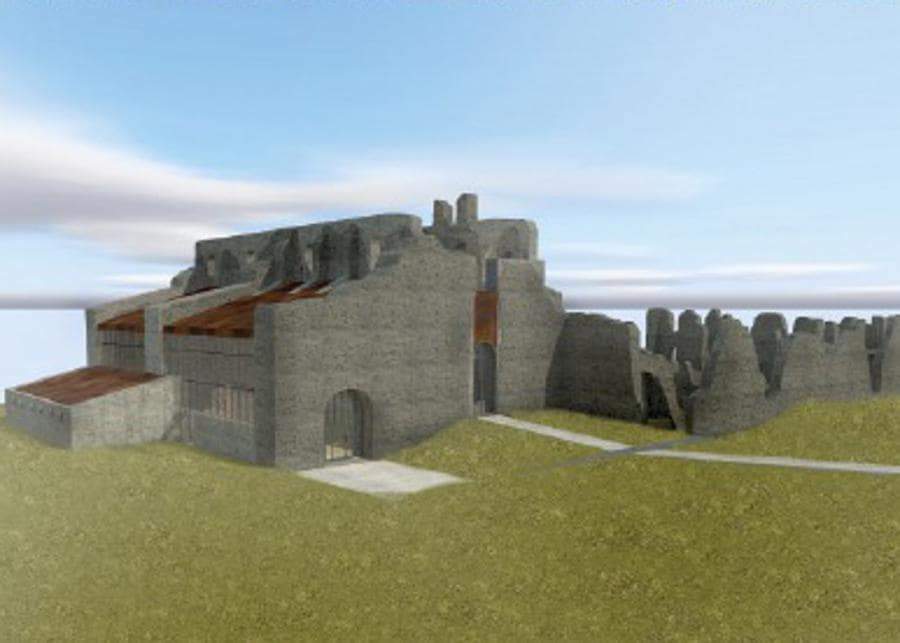 |
| Corazzo Abbey, Rendering of the restoration |
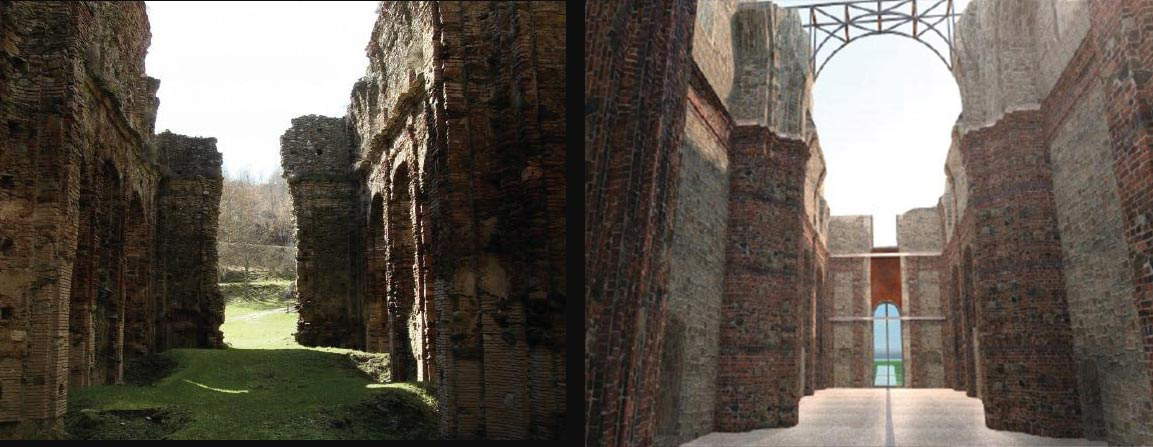 |
| Corazzo Abbey before and after restoration |
Corazzo Abbey. Here is the history
The ’Abbey of Santa Maria di Corazzo, in the territory of Carlopoli, a small town in the Presila of Catanzaro, is of Cistercian plan, which means that it is an architectural structure that is grafted into the groove of the history and culture of European monasticism.
Traces of the pre-existing Benedictine foundation, dating back to 1060 (for some scholars even before that year), seem to be nowhere to be found and, with good grace of archaeological research, do not even seem to be necessary: the Cistercian abbeys built their buildings ex novo , as Carlo Tosco argues , without therefore taking into account the previous context. What they did consider, however, was their surroundings: the silence for meditation, the forest, the watercourse. Values that are still invaluable today.
Sticking to a precise organization of life by the monks and abbots was fundamental for the Cistercians. Because it was a monastic congregation born in the wake of that tradition conceived by the rule of St. Benedict, it provided for an almost absolute rigor for ascetic life, an inflexibility equal to pragmatism, because the monks were devoted to planning nature, with planting and extensive reclamation operations. A righteous, active and contemplative conduct of life then, which they imagined possible only if the abbey was located in solitary places, far (at least at the beginning of the birth of the order) from the frequentation of men. We are well aware, however, that in the course of the 12th - 13th centuries, many things would change and the strict rules of the order would slowly be softened (for example, the prohibition of the use of money and business practices would be circumvented by resorting to the performance of these tasks by the conversi). However, beyond the strict rules, what is most important to emphasize is that the abbey had a long life and was a fundamental junction for the penetration of Latin monasticism in Calabria, a door opened by the Normans and Robert Guiscard, who also made a decisive mark on these lands architecturally.
The story of the abbey of Santa Maria di Corazzo lasted about 700 years, with a succession of dates ranging from that of the Cistercian refoundation (or would it be better to say “florense”? because of Joachim of Fiore’s role as abbot), to that of the 1638 earthquake, with dramatic moments continuing in the 18th century, when it was completely destroyed by the other devastating earthquake of 1783, and then in 1796, dismantled with the dispersal of its property. Napoleonic requisitions and suppressions would do the rest, “consecrating” the abbey as a victim of spoliation and a quarry site from which to recover building materials. The year 1807 is that of its final death.
But perhaps another life still flows under its ruins, and although the monks have long since abandoned those places, the abbey has never ceased to throb “among desert, water and woods” (E. Zinzi). It has been and still is, an integral part of the cultural life of the area. Within the collapsed walls of the cloister, for example, numerous concerts of music of great national quality and beyond have been held. Concerts, however, which, in all likelihood, have further compromised the tightness of the structures, because a plan for the recovery of the ancient walls and a concrete restoration project as well as minimal routine maintenance have long been lacking.
Corazzo, it is true, has always been a city of God, “an ideal city and an expression of a highly political organization between individuals and the living environment.” But it is above all a ruin, to be protected. The burning fragment of an enchanted landscape. Why then interrupt its dream? Why shatter Gioacchino da Fiore’s utopian vision, compromising the preciousness of its silences and mystifying its memory with a project, not better clarified, that seems to aim at redeveloping its spaces by betraying its original vocation as an "ideal city " ?
Why must the nature-human balance now be broken, allowing perhaps, that a chattering and fashionable tourism advances among these woods and silences ? What is the vision that illuminates the project? Make it another “location” for festive weddings?
Can adapting the spaces of the seven arches for the construction of a museum be plausible? True, the scattering of 18th-century furnishings, scattered among the churches in the district, would have to be recomposed through a musealization operation and the presence of an “antiquarium”. But would it not also be important to provide with those funds more adequate tools to finally publish the results of the excavations by the British School in the 1980s-1990s? And perhaps, return to light the parts that have not yet emerged by funding more excavations to be carried out by a team of unequivocal depth and expertise? Perhaps one that is outside the electoral power games?
The value of the abbey, however, goes far beyond controversy just as it far exceeds the significance of the Cistercian facility. Beyond Joachim and as a testimony to European monasticism, it is also placed in history and in our imagination by its peculiar character as a “landscape of ruins”-in a word, it is a ruin with a “romantic” sensibility, set, by the way, in a land where the presence of nature still predominates.
Indeed, we should understand its being a ruin as imagined by the great theorists of the aesthetics of ruins in the late eighteenth century, Ruskin, for example, who found anchored in the perception of the beauty of the ancient its authenticity even at the cost of going along with its slow decline. An ancient monument would reach its peak only after the passage of a few centuries.
But not only for Ruskin. Important would be to ask even today what a ruin is. What meaning does it possess as an “asset” of a “heritage” to be protected, and what is its purpose? We must therefore update its meaning and remap the state of the art. A few years ago, an exhibition curated by Marcello Barbanera and Alessandra Capodiferro, Ruins. The Power of Ruins opened a window on this theme. The exhibition, held in the precious rooms of Rome’s Palazzo Altemps in 2013, made clear the ambivalence and mutability of the concept and of ruin itself. Posing with plenty of parallels even examples of collapse, and rubble. Things however, quite different from historical-architectural ruins. But the questions that arose and the assumptions with which the idea of the exhibition was born (which was intended to reconsider how the idea of Ruin, particularly of Rome was from time to time either “suggestive” or “disturbing,” “terrible,” and finally “identity”) would be for our case and must be considered for the Abbey of Corazzo.
Where, by the way, we reiterate, there has been a lack not only of public discussion (we hope soon possible) between administration and experts, between communities and the most diverse professionalism; but, more seriously, for an asset such as this, which admirably condenses the profound meaning of “cultural asset” and heritage both of a “material” and “immaterial” nature, there has been a lack of a proposal for an international competition that would clearly set out the reasons for the project, as well as the methods, techniques and consider the most appropriate materials to be used. What is regrettable is that a more forward-looking, open and less localistic vision in approaching the issue has also been lacking. The gaze is that of the mole. Nothing more, nothing different that makes Calabria “catch its breath.” Nothing that makes this region emerge out of the logic of compromise and myopia.
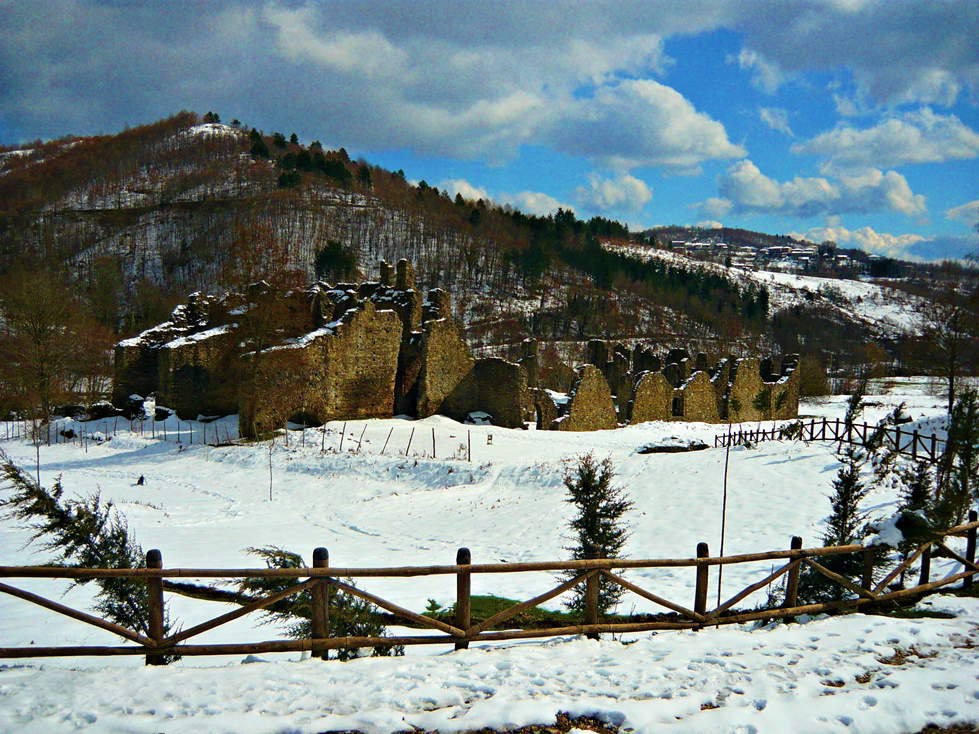 |
| The abbey of Corazzo. Ph. Credit |
 |
| The Abbey of Corazzo |
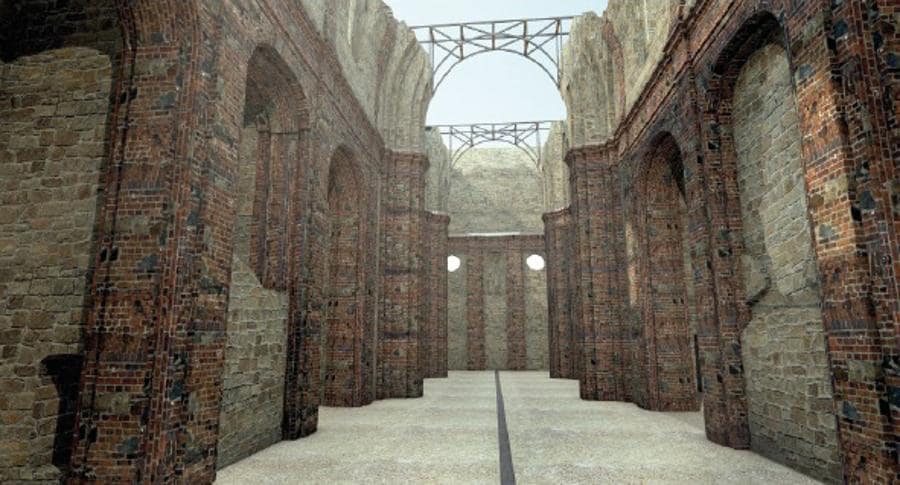 |
| Corazzo Abbey, Rendering of the restoration |
 |
| Corazzo Abbey, Rendering of the restoration |
The interview with Salvatore Settis
We asked Salvatore Settis, a distinguished art historian and archaeologist of Calabrian descent, for his opinion on the case.
ADF. Professor, how can we define the value of a (ancient) “ruin” today? And in particular a fascinating and historical ruin like this one, which represents for the Calabrian territory and beyond, an important “resource” as well as a precious testimony of a past that deserves to be relived, protected, known?
SS. Too often we forget that what we call ’Renaissance,’ that is, “new birth,” was born from the ruins of ancient Rome. Ruins, if understood, studied, respected are the fruitful heart of thoughts, projects, experiences and experiments. In this moral and spiritual sense, much before economic or tourist calculations, ruins are a resource, or rather they can be. It depends only on us.
How do you imagine we can really restore the abbey without damaging its structures and disqualifying its dignity as a “ruin”? And how to enhance it, considering that this splendid sign of the past is set like a precious jewel in the heart of a region of Italy that in certain terms is still struggling?
I have only been to Corazzo once, in winter and snow, and I was enchanted. Ruins are not only important historically, but also aesthetically and in relation to the surrounding landscape. They need to be consolidated, but absolutely not “completed,” just as it would be folly to “complete” the Colosseum or the monuments of the Roman Forum, or (to stay in Calabria) it would be foolish to want to complete the temple of Hera Lacinia near Crotone, of which only a single column remains standing. Respect for the ruins and legal regulations on preservation dictate preservation, and any form of “completion” would not be on the side of preservation, but of destruction of historical and heritage value.
" Of this, as of other excavations, it is supposed, that they were conducted without any scientific rigor, more with the intention of snatching a treasure, than of recovering a venerable relic of one’s historical memory " (R. Spadea, L’archeologia e la percezione dell’antico).
The intent of the article is to invite, in addition to Professor Salvatore Settis, other experts (and not) to participate, constructively criticize, suggest and intervene taking as a pretext the solicitations and provocations, we admit even stinging, contained herein. The debate must continue, our beauty and memory depend on it.
Warning: the translation into English of the original Italian article was created using automatic tools. We undertake to review all articles, but we do not guarantee the total absence of inaccuracies in the translation due to the program. You can find the original by clicking on the ITA button. If you find any mistake,please contact us.